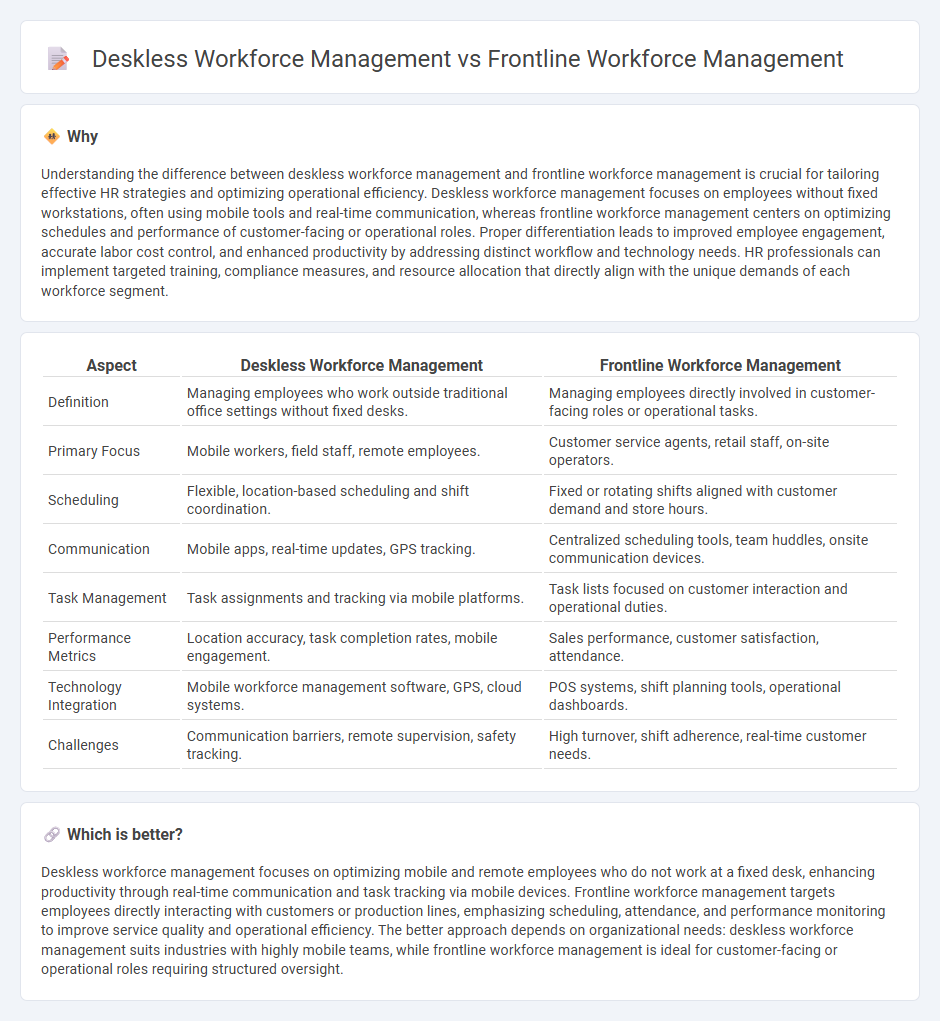
Deskless workforce management focuses on optimizing the productivity and communication of employees who perform their duties outside traditional office settings, such as retail associates, healthcare workers, and field technicians. Frontline workforce management, a subset of deskless management, specifically addresses the scheduling, task allocation, and real-time support for customer-facing staff to improve service delivery and operational efficiency. Explore how advanced workforce management solutions can enhance both deskless and frontline employee performance.
Why it is important
Understanding the difference between deskless workforce management and frontline workforce management is crucial for tailoring effective HR strategies and optimizing operational efficiency. Deskless workforce management focuses on employees without fixed workstations, often using mobile tools and real-time communication, whereas frontline workforce management centers on optimizing schedules and performance of customer-facing or operational roles. Proper differentiation leads to improved employee engagement, accurate labor cost control, and enhanced productivity by addressing distinct workflow and technology needs. HR professionals can implement targeted training, compliance measures, and resource allocation that directly align with the unique demands of each workforce segment.
Comparison Table
| Aspect | Deskless Workforce Management | Frontline Workforce Management |
|---|---|---|
| Definition | Managing employees who work outside traditional office settings without fixed desks. | Managing employees directly involved in customer-facing roles or operational tasks. |
| Primary Focus | Mobile workers, field staff, remote employees. | Customer service agents, retail staff, on-site operators. |
| Scheduling | Flexible, location-based scheduling and shift coordination. | Fixed or rotating shifts aligned with customer demand and store hours. |
| Communication | Mobile apps, real-time updates, GPS tracking. | Centralized scheduling tools, team huddles, onsite communication devices. |
| Task Management | Task assignments and tracking via mobile platforms. | Task lists focused on customer interaction and operational duties. |
| Performance Metrics | Location accuracy, task completion rates, mobile engagement. | Sales performance, customer satisfaction, attendance. |
| Technology Integration | Mobile workforce management software, GPS, cloud systems. | POS systems, shift planning tools, operational dashboards. |
| Challenges | Communication barriers, remote supervision, safety tracking. | High turnover, shift adherence, real-time customer needs. |
Which is better?
Deskless workforce management focuses on optimizing mobile and remote employees who do not work at a fixed desk, enhancing productivity through real-time communication and task tracking via mobile devices. Frontline workforce management targets employees directly interacting with customers or production lines, emphasizing scheduling, attendance, and performance monitoring to improve service quality and operational efficiency. The better approach depends on organizational needs: deskless workforce management suits industries with highly mobile teams, while frontline workforce management is ideal for customer-facing or operational roles requiring structured oversight.
Connection
Deskless workforce management and frontline workforce management are interconnected through their focus on coordinating employees who operate outside traditional office environments, such as retail, healthcare, and manufacturing sectors. Both require real-time communication tools, scheduling software, and performance tracking systems to optimize productivity and engagement. Leveraging mobile technology and cloud platforms enhances operational efficiency and ensures seamless alignment of workforce tasks and organizational goals.
Key Terms
Frontline workforce management:
Frontline workforce management involves optimizing scheduling, time tracking, task allocation, and communication for employees who interact directly with customers or operate on the front lines, such as retail staff, healthcare workers, and field technicians. This approach leverages real-time data analytics and mobile tools to enhance productivity, reduce labor costs, and improve customer satisfaction by ensuring the right people are in the right place at the right time. Explore advanced strategies and technologies shaping frontline workforce management to boost operational efficiency and employee engagement.
Shift Scheduling
Shift scheduling for frontline workforce management prioritizes operational efficiency in environments like retail and healthcare, where predictable, repeatable tasks and fixed locations are common. Deskless workforce management shift scheduling adapts to highly dynamic schedules often found in field services and gig economy roles, emphasizing flexibility and real-time updates via mobile platforms. Explore how tailored shift scheduling solutions can transform productivity and engagement in your workforce.
Performance Tracking
Performance tracking for frontline workforce management involves real-time monitoring of employee activities, task completion rates, and customer interactions to enhance operational efficiency. Deskless workforce management specifically emphasizes mobile-friendly solutions, enabling supervisors to track performance metrics such as attendance, job progress, and productivity directly from smartphones or tablets. Discover how advanced performance tracking tools can revolutionize your workforce efficiency and employee engagement.
Source and External Links
Frontline workforce - Definition, benefits & strategies - Frontline workforce management is crucial as it supports essential employees who operate physically on-site and have direct customer or operational roles, requiring organizations to invest in tools and strategies for flexibility, engagement, and resilience to improve employee satisfaction and business success.
Frontline Workforce Management in the Transportation, ... - Effective management of frontline workers in industries like transportation and hospitality, focusing on trust, transparency, performance measurement, and leadership for worker well-being, enhances business outcomes and customer relationships.
7 best practices for managing frontline employees - Blink - Key practices include thorough onboarding, active listening, clear communication, and supportive care to engage frontline employees and improve operational performance.
 dowidth.com
dowidth.com